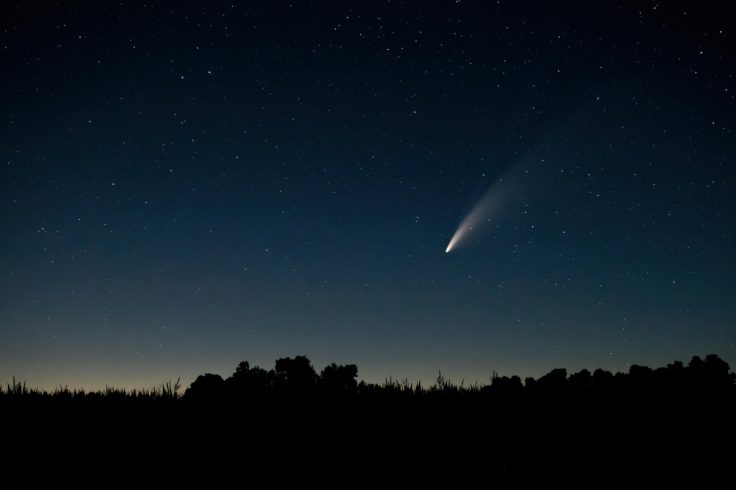Where Is the Comet's Tail? Loeb Raises Red Flag as Luna Demands Answers on 3I/ATLAS
Harvard scientist Avi Loeb flagged multiple anomalies, suggesting it may not be a normal comet

The behaviour of a celestial object has sparked a cosmic debate. Astronomers are accustomed to comets sporting a bright, distinctive tail as they zoom near the Sun. So, when the object 3I/ATLAS was spotted, it instantly piqued curiosity.
But its lack of a signature tail has led to profound questions from researchers like Avi Loeb, who is now sounding the alarm. As the scientific community demands explanations, is 3I/ATLAS a comet, an asteroid, or something else entirely? The mystery deepens.
Fresh Views, Missing Trail
On 5 November 2025, two updated pictures of the interstellar visitor 3I/ATLAS were released. The images show a small, bright point of light that lacks a clearly identifiable tail of dust and gas. 'The coma is not very different in morphology from its appearance in the Hubble Space Telescope on 21 July 2025', Avi Loeb wrote in his most recent post on the website Medium.
The 63-year-old Israeli-American scientist noted that this observation is unexpected, particularly given the JPL report from NASA. That report mentioned a non-gravitational acceleration, with figures normalised to a heliocentric distance of one astronomical unit (1 au), as follows:
1.1 x 10$^{-6}$ au per day squared: This is the acceleration moving away from the Sun, or radial acceleration.
3.7 x 10$^{-7}$ au per day squared: This is the acceleration sideways relative to the Sun's position, or transverse acceleration.
Using the principle of momentum conservation, Loeb calculated that the object 3I/ATLAS shed a mass fraction greater than 13% during its closest approach to the Sun (perihelion passage).
He also stated that 'For a typical comet, this should have resulted in a massive coma with dust and gas that would have been pushed by the solar radiation pressure and the solar wind to the shape of a typical cometary tail pointing away from the Sun. No such tail is visible in the new images from 5 November 2025'.
In comparison, he included a photograph of the Solar System visitor, Comet Lemmon, in his blog entry. This picture was taken by one of the same telescopes that observed 3I/ATLAS two days before. Lemmon clearly displays the expected cometary tail, streaming away from the star.
READ MORE: 3I/ATLAS Challenges Models of Comet Behaviour After Highest Eccentricity Recorded
READ MORE: 3I/ATLAS Shock: Comet Repeats 'Alien Tech' Anomaly
The List of Puzzling Features
The strange characteristics demonstrated up to now by the object 3I/ATLAS include the following:
- Its path, which moves backwards (retrograde trajectory), is lined up within five degrees of the Sun's planetary ecliptic plane, a phenomenon that has a 0.2% chance of occurring.
- In July and August 2025, it showed a jet of gas aimed towards the Sun (an anti-tail). This is genuinely real and not just an optical trick caused by perspective, unlike what we see with typical comets.
- Its central body (nucleus) is about one million times heavier than 1I/'Oumuamua and one thousand times heavier than 2I/Borisov. It is also travelling faster than both, with all these traits together having a less than 0.1% chance of coincidence.
- Its arrival time was precisely adjusted to bring it within tens of millions of kilometres of Mars, Venus, and Jupiter, and yet it was not viewable from Earth during its closest solar pass, an event with a 0.005% likelihood.
- The gaseous cloud contains significantly more nickel than iron (a mix commonly found in manufactured nickel alloys). Crucially, the nickel-to-cyanide proportion is significantly greater than that found in all other known comets, including 2I/Borisov, which is a situation with a likelihood below 1%.
- Only 4% of the gas cloud's mass is composed of water, a key ingredient in standard comets.
- It displays extremely negative light polarisation, which has never been observed in any other known comet, not even 2I/Borisov, with this phenomenon having a likelihood of less than 1%.
- It came from a direction that perfectly matches, to within nine degrees, the source of the radio 'Wow! Signal', an event with a 0.6% likelihood.
- As it neared the Sun, it grew brighter quicker than any previously observed comet and was bluer than the star itself.
- It shows movement that is not due to gravity, which demands a massive amount of material — at least 13% of its total mass — to vaporise. However, the initial photographs taken after its closest solar approach do not yet confirm the expected resulting evidence.
These significant anomalies and the perplexing lack of a visible tail have not only captured the attention of leading scientists but have also drawn commentary from political figures.
READ MORE: Congresswoman Luna Calls for Full Disclosure on 3I/ATLAS Composition — Public Seeks Answers
READ MORE: 3I/ATLAS Now Visible From Earth — A Once-in-Generations Viewing for the Public
Congress Weighs In: Luna Demands Answers
The public conversation took a sharp turn when Representative Anna Paulina Luna posted a significant update on X (formerly Twitter), directly addressing the mystery of 3I/ATLAS. She revealed she had 'a good conversation with @NASA' regarding the object, confirming that the space agency would release more 'images/data' once the government reopened, noting that 'bureaucratic reasons' prevented immediate disclosure.
Just had a good conversation with @NASA regarding 3I/Atlas. As soon as the government reopens, they’ll be releasing images/data. Unfortunately, due to beaucratic reasons they cannot until then. Dr. Avi Loeb @GalileoProject1 (@Harvard) was correct in his early analysis of the…
— Rep. Anna Paulina Luna (@RepLuna) November 5, 2025
Crucially, Luna threw her support behind the Harvard scientist's findings, stating, 'Dr. Avi Loeb... was correct in his early analysis of the abnormal tail. NASA has also noted this'. This statement directly supports Loeb's recent blog post, in which he detailed how the non-gravitational acceleration should have created a massive, standard comet tail; yet, the 5 November images showed none.
Luna expressed optimism for future discoveries, concluding that 3I/ATLAS would be 'one of many interstellar objects that we will be able to track now that technology has advanced'.
Her post highlighted the bureaucratic hurdles in releasing information. It confirmed that the scientific community, at the highest levels, is focused on the 'abnormal tail' feature that first raised Loeb's red flag.
© Copyright IBTimes 2025. All rights reserved.





















